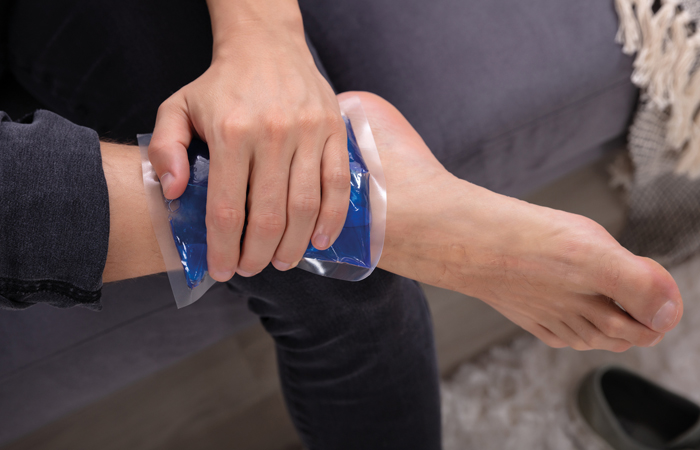In OTC
Follow this topic
Bookmark
Record learning outcomes
With more than 200 bones and at least 600 muscles, the human body is certainly remarkable – but as with anything comprising that many parts, there’s also scope for things to go wrong. It’s perhaps not entirely surprising, then, that nearly a third of the UK population has some sort of musculoskeletal condition.
Prevention before pain
The neck, lower back, knees and feet are common areas for complaints, says Doctor of Chiropractic Emma Burniston. Pain may strike suddenly, for example due to an injury, or come on more gradually – but shouldn’t be ignored. “Pain is like an iceberg,” says Emma. “By the time somebody feels it, unless it was an acute injury, then the body has normally been dealing with that problem for a lot longer.
“What many people do is ignore the niggles; they’ll have a twinge when bending over maybe, or sitting for long periods, then suddenly this little niggle keeps building up. I always say see your body like a car, which needs maintaining even when it’s not broken down. Many people go around thinking that their body is strong enough and they can do whatever they like to it – sit for long hours, not do much movement, not bother with good hydration and nutrition – and then on top of that they may not be doing any strength work or something to improve its performance.
“This is the reverse of what we should be thinking – we should be getting our bodies checked, our alignment checked, our movement checked on a regular basis. My advice is don’t wait until you’re in pain: find a trusted practitioner who can make sure your body is working and moving as good as it can be.”
Musculoskeletal conditions can affect patients in a myriad of ways, from struggling to dress themselves or climb stairs to hindering sleep, work, or relationships. “It can also affect caring for little ones – things like lifting up children, getting babies out of prams, bending over to wash kids in the bathtub,” points out Emma.
Patients who are worried about joint pain should see their doctor rather than attempting to self-diagnose. However, once the cause has been confirmed, pharmacy staff can play a key role in supporting patients, both in terms of lifestyle advice and OTC treatment options. As with any medicines, always consider the patient’s age and any contraindications.

Many aspects of daily life can lead to small niggles and twinges that can build into real muscular and joint problems over time.
Arthritis
More than 10 million people – around one in six – have arthritis in the UK. “There are over 200 forms – some are very rare and may not even be called ‘arthritis’ – so it’s very much an umbrella term, a bit like saying ‘cancer,’” explains Clare Jacklin, CEO of the National Rheumatoid Arthritis Society (NRAS).
A study published in The Lancet Rheumatology in 2023, led by the Institute for Health Metrics and Evaluation, predicts that nearly one billion people will be living with osteoarthritis (OA) – the most common type of arthritis – by 2050. At present, around 1,000 people in the UK are diagnosed with it every day, according to Versus Arthritis.
With OA, cartilage – the flexible tissue that protects the joint – breaks down, which can lead to pain, swelling and stiffness. Frequently affected areas include the hips, knees or hands. A widespread misconception is that it’s simply “wear and tear”, but this is untrue and unhelpful, according to Versus Arthritis.
The second most common form is rheumatoid arthritis (RA), a type of inflammatory arthritis. There are currently 450,000 adults living with RA in the UK, says Clare. “RA is an autoimmune, systemic, incurable condition that can impact on other organs of the body, not just joints,” she explains. “While RA tends to be symmetrical, impacting both shoulders, both knees, both hands etc., OA might affect one or two joints.
“RA isn’t hereditary but there is genetic pre-disposition that may put people at a higher risk of developing it,” she continues. “Lifestyle factors can also increase the risk of developing RA or the symptoms worsening. Smoking is probably the biggest risk factor. If someone with a family history of autoimmune conditions smokes, they are doubling their risk of developing RA – and if someone develops RA and continues to smoke, they potentially reduce the efficacy of the medications they are taking. Weight management and healthy eating is also very important, as people with inflammatory, autoimmune conditions like RA are at higher risk of developing cardiovascular disease. Exercise is also really important for maintaining bone and muscle strength.”
Contrary to common belief, arthritis is not the preserve of pensioners; RA can strike at any age. “Onset is most prevalent in the prime of life, aged 40-60,” explains Clare, and there are 12,000 children and young people in the UK living with juvenile idiopathic arthritis. However, according to Versus Arthritis, OA prevalence increases with age, and by 75, almost half of us will have it, adds consultant rheumatologist, Dr Benjamin Ellis, the charity’s senior clinical policy advisor.
Figures show that both OA and RA are more common in females. “Three times as many women as men have RA,” points out Clare, while Dr Ellis says that “of the 10 million living with osteoarthritis in the UK, six million are women”. On the other hand, gout – a type of arthritis where the body’s uric acid levels are too high, causing urate crystals to form around joints – is more common in men.
When assisting arthritis patients, it’s important for pharmacy teams to recognise that there is no one-size-fits-all approach. “It is important to think about all the types of arthritis conditions as different diseases, as while there are some similarities, the way they are treated is very different,” says Clare. “RA is most commonly treated with disease-modifying anti-rheumatic drugs (DMARDs) that are prescribed by a physician. Pain relief such as paracetamol is of course available to purchase over-the-counter, and vitamin D is highly recommended in addition to DMARDs.”
“Always check people’s understanding of their condition,” says Dr Ellis. “Community pharmacists can have a role helping people navigate health services, and if someone doesn’t know what their diagnosis is, you could suggest they speak to their GP. Make sure you’re up to date on modern explanations about common conditions such as osteoarthritis, and rheumatoid arthritis – no more talk of ‘wear and tear’! You’ll find useful information on the Versus Arthritis website: versusarthritis.org and you could even stock some free information booklets for customers.”

Muscle memory
Muscle complaints can arise for a variety of reasons, including poor posture, stress, side effects of medication, an injury, or illnesses such as flu and Covid. “It’s common to have muscle and joint aches and pains from time to time,” says Dr Ellis. “This may especially be true if someone takes part in unusual or strenuous physical activities.”
Sore muscles normally mean that those muscles are under too much stress, and that stress needs to be taken away,” says Emma. “Sometimes they go hand in hand with tight muscles, so doing some gentle stretches around the affected area could be beneficial. Sitting in a warm bath with Epsom salts for 20 minutes may help; Epsom salts have magnesium in, which is good for tired muscles. And there are a lot of different muscle rubs on the market, some of which have ibuprofen in and some don’t.”
A viral illness such as flu or Covid can cause aching, alongside symptoms such as fever, cough, sore throat and fatigue. (One study of 150 hospitalised Covid patients, published in the European Journal of Physical and Rehabilitation Medicine, found that 68 per cent experienced muscle aches and pain – also known as myalgia.) In many cases, the aching will ease as the patient recovers, however, if the problem persists or worsens they should seek medical advice.
Occasionally, a patient might suspect that the problem could be a side effect of medication. Statins, for example, can sometimes cause muscle swelling – though a study published in The Lancet in 2022 concluded that the treatment was not the cause of muscle pain in more than 90 per cent of those reporting symptoms. In these circumstances, patients should be referred to the pharmacist or their GP; they can also report suspected side effects to the MHRA under the Yellow Card scheme.
Leg cramps or spasms can occur for a wide variety of reasons, including dehydration, pregnancy and overexertion during exercise. Though painful, they usually don’t last long, and stretching or massaging the affected area may help to ease discomfort. Patients should see a GP if cramps last more than 10 minutes, disturb sleep, or are accompanied by swelling or numbness.
“Muscular dystrophies are a group of inherited genetic and progressive conditions that gradually cause the muscles to weaken and get worse over time,” says Rob Burley, director of Campaigns, Care and Support at Muscular Dystrophy UK. “There are more than 60 conditions and each one has different symptoms”, he continues, “which might include pain, difficulty walking, heart problems, breathing complications or trouble swallowing”.
“Muscle wasting and weakening conditions are caused by changes (mutations) in the genes responsible for the structure and functioning of a person’s muscles, which are often inherited,” adds Rob. “Should people be concerned, speaking with a healthcare professional would be advised.”
Affecting over 110,000 people in the UK, there is currently no cure for muscular dystrophy, but steps can be taken to help patients manage their condition. These might include physiotherapy, medication, surgery and mobility equipment. “Pharmacy staff can play an essential role in supporting patients, ensuring patient safety and adherence to treatments, and provide further advice to other healthcare professionals involved in the care of someone living with a neuromuscular condition,” says Rob.


